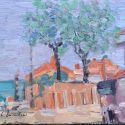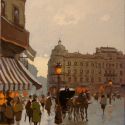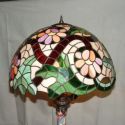On George Bacovia Street, No 63, in a quiet and peacefull area of small houses and narrow streets, one could not easily find the memorial house of one of the most important and original Romanian poets, George Bacovia. Even by today's standards it is a rather impressive building, made in a manner that was very popular after the Second World War - simple lines, very straight and without ornaments, all the house being made out of rectangles. When it was made, in the 30's, it was one of the largest and most elegant in this poor, working class neighbourhood, and it was made most of all with the desperate efforts of the poet's wife, Agatha Grigorescu Bacovia, herself a poet and writer. The house also has a small and beautiful garden, where Bacovia used to rest and enjoy the calmness of nature, which reminded him so much of his hometown, Bacau. There is also a small statue of the poet, an image of him in the later years. There is much peace here, at the George Bacovia Memorial House, one of the most important places of this kind in Bucharest, although it is also almost unknown. Few visitors come here, and those who take care of the museum, still filled with Bacovia's presence, can not complain of overwork. Sadly, for the work and life of this incredible and intense author are, without a doubt, more than interesting for all.
George Bacovia lived in this house starting with 1933, moving several times back to Bacau, only to return once again to Bucharest, with or without his wife Agatha and son, Gabriel. It is in one of these rooms that he passed away in 1957, leaving behind one of the most fascinating works in the history of Romanian literature. In the memorial house, oficially opened in 1966 at the request of the family, visitors can find most of the rooms, exactly as they were when the poet died, with the original furniture, carpets, books, photographs and personal objects, all of them making up an impressive collection. In the living-room of the house, maybe the largest room, you can see the armchairs where the family enjoyed their rest, an old radio, some old and elegant bookcases, with the favourite books of Bacovia - many of them works by French authors, published by Mercure de France, as well as the works of most of the Symbolist writers - and several old paintings and photographs. There is also a small room, left from the main entrance, where Bacovia liked to stay and write, read or think, where he enjoyed a cigarette or talked with his son. It is a small space, with a narrow bed, a bookcase, a small desk and chair. On the desk there is a pencil and the poet's ashtray and cigarette holder, the shelves of the bookcase are filled with books and photographs, there is something both intriguing and romantic. Also, you get really emotional thinking that is was here that George Bacovia wrote some of his last poems. The story says that the clock you can see on the wall stopped precisely at the writer's time of death. Though it is most likely just a story, it is a good one.
Apart from the furniture, books and personal objects, the memorial house also has an impressive collection of manuscripts, letters, original documents of George and Agatha Bacovia - rather few actually, as the poet often destroyed his notes and writings, as well as letters. Also, the selection of books by and about Bacovia, published over the years in several countries and different languages is also impressive, starting with the first editions of his poetry volumes, today extremely rare and fetching rather high prices among collectors. Also, visitors can see the poet's violin - he was a skilled and passionate musician, although pretty much selftaught.
There is another such memorial house in Bacau, but it is in much worse shape and needs urgent and expensive renovations.
George Bacovia - some biographical data
Born Gheorghe Vasiliu, George Bacovia is one of the most important Romanian poets of the 20th century, considered by many a Symbolist writer, although his poems and other texts show a mix of influences, as well as a profound originality. Despite the fact that before the Second World War he was considered to be a strange, yet uninteresting poet - George Calinescu, one of the greatest critics, put him in the same league with other Symbolists, now forgotten - he had the strength to influence Romanian literature especially after his death, when his work was rediscovered with great enthusiasm.
Born in 1881 in Bacau, he went to highschool there and later enrolled at the University of Bucharest, where he studied Law, according to the family's wishes. A very shy, neurotic person, with a tremendous fear of crowds and human company, Bacovia was the ultimate image of the Romantic poet, in a Symbolist and decadent universe, marked by infinite and rotting rains, graveyards, the overpowering stench and presence of Death, lost loves, sickness and abandon, powerty and social injustice, long winter nights, fears and deceptions. He was, for those who knew him, a fascinating man and a good friend, yet few could say that he accepted them. Especially later, in the Communist years, when he would be "recovered" due mainly to his early leftist sympathies, he was regarded like a true master. Which was true, despite the fact that for most of his life his volumes of poetry sold poorly, were attacked several times by critics and other writers, and the poet himself had to resort to menial jobs.
He was a close friend and protegee of another interesting and controversial Romanian poet, Macedonski, who first published some of Bacovia's poetry and presented the much younger writer as a great, original talent. Due to his lack of social skills, modesty and fear of the real world and others, Bacovia couldn't make himself a part of the literary world, didn't have many protectors and even fewer sponsors, and it is safe to say that for most of his life he was virtually unknown to the public. His great chance, in a life where he hid from the world, abandoned several times his studies and preffered to hide in his room, where he read, wrote, played violin or dreamed with his eyes opened, would be his wife. Agatha Grigorescu-Bacovia - with whom he will also have a son - was a poet, but also a harsh woman, a fighter, who decided to stand against all, to promote her husband's creations. This would be very true especially after 1957, when Bacovia passed away, and his wife made the best to preserve his legacy. In no small part, the opening of the memorial house in Bucharest was her work.
Bacovia published his first volume of poetry, Plumb (Lead) in 1916, at a small and poor publishing house, with little to no success, despite some critical acclaim from Macedonski and other writers. The next few volumes, such as Scantei galbene (Yellow Sparks) in 1926, Bucati de noapte (Pieces of Night - prose) in 1926, Cu voi (With You) in 1930 or Comedii in fond (Comedies at Heart), although today considered extraordinary and original, practically reinventing the poetical language, were met with little interest by the public. We can even say that the attacks were much harder and more present that the awards of any kind. Only after the Second World War, when the poet was used by the Communist regime, and his works were finally published in tens of thousands volumes, Bacovia gained the popularity that he deserved. Sick and tired, after a life long of defeats, dissapointements and losing, he died at his hime, in 1957, after a short yet brutal suffering.
George Bacovia is an interesting poet, as he managed to mix the Symbolist elements, very present in his first texts, with modern elements that would not be largely used much, much later. His work is marked by the presence of death, decomposition, sadness, agony, losing all that is important, failure at accepting and enjoying life. But it is not the expression of someone who lost, but of someone who couldn't have won, no matter how he tried. Because he wasn't meant to.
It is also interesting to know that his name, Bacovia, still remains a mistery when it comes to it's origins. In an interview given in the 30s, the poet jokingly said that it meant "Bacchus via" - The Way of Bacchus, "a way that I undertook one too many times". Yet, according to another confession, it was inspired by the Latin name of Bacau, taken from the dictionary compiled by Hasdeu, as Arghezi might have done also. Whatever the real reason was, it was an inspired name, which became one of the great names of Romanian poetry. Pity these authors are not as popular as they deserve to be.
2007-12-05

































